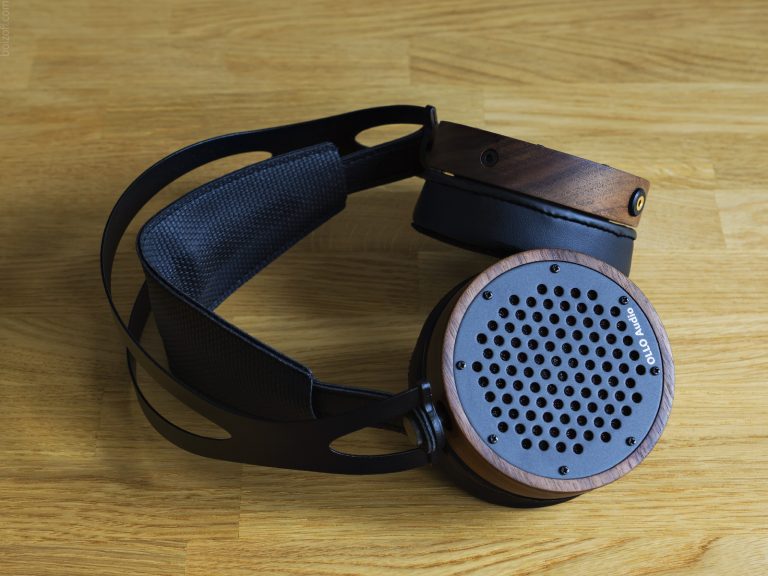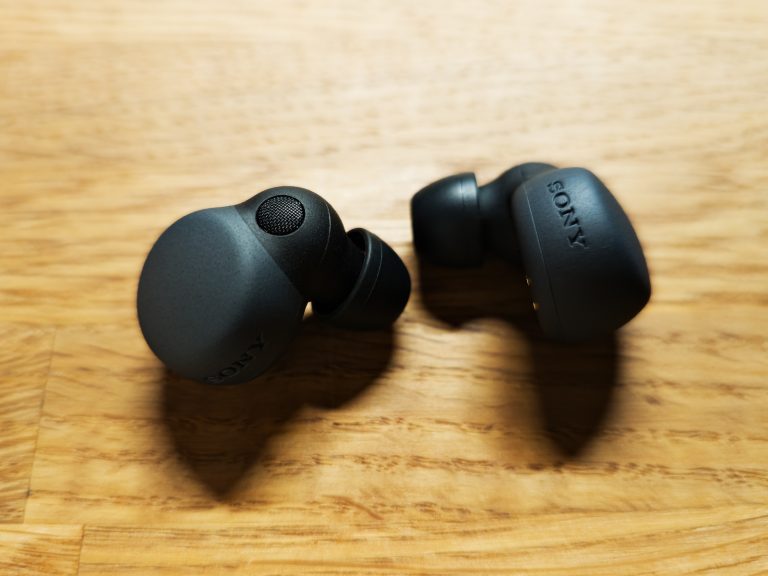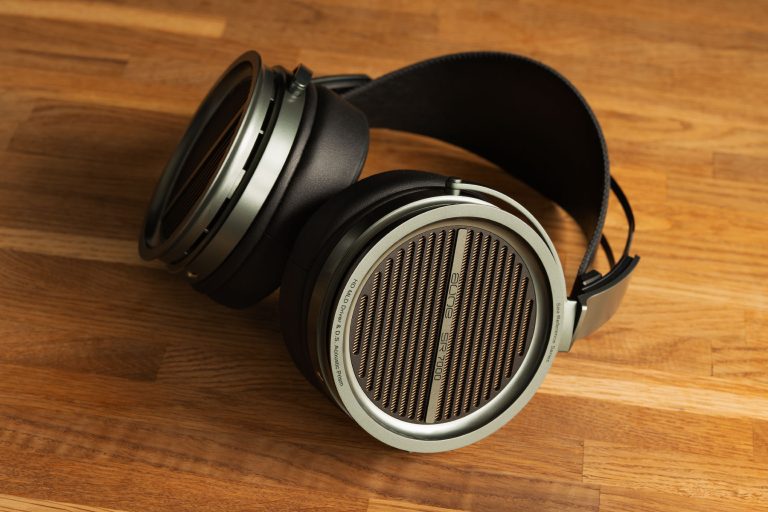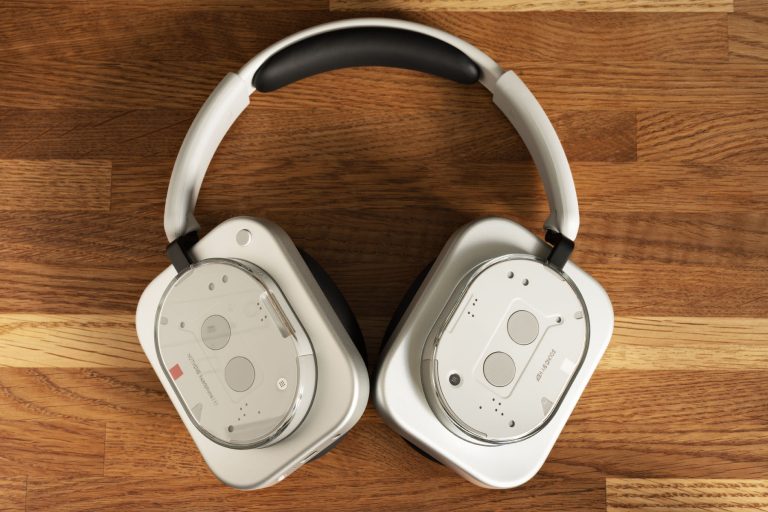Moondrop ALICE TWS headphones review. You can try, but you wouldn’t want to buy
The Moondrop brand owned by Shenzhen Audio manufactures some uncompromising ALICE audiophile-grade TWS headphones. These use a super-linear proprietary dynamic driver with a carbon aperture, a progressive QCC5151 chip, and a VDSF+ technology to expand the soundstage. And, most importantly, you can customize their sounding all you want with a parametric equalizer via a proprietary app.
As you can see, I couldn’t resist – I had to test them in real life.
Important! While working on this review, the following software versions were used.
- 2.0.2 as the headphones firmware version
- 1.3.5 as the Moondrop Link app version
What’s included
The outer packaging was so tightly hugging the box I was afraid I could tear it while unpacking. When I failed the first attempt to free the box, my thought was that there’s some more adhesive tape left somewhere around, but no, it’s just packed like this. Oh, so tight.
What do you get:
- the headphones themselves;
- the case;
- the case cover;
- 2 sets of eartips;
- some papers.

And all this takes no more than like 30% of the box space. The box is just giant, by the way.
Build, materials, design
The case features that minimalistic premium Made in China style. Not in that ‘Made in China! Ha!’ way, but in the modern tech ‘Made in China’ way. It’s an obvious and rather good example of that trend set by Xiaomi and other leading technology brands in China. The case feels like a monolithic piece of high-quality plastic – not a single gap or seam is there. The lid is kind of loose, though.

There’s only a USB Type-C connector on the backside.
Once you open the case, the charge indicators light up immediately.

The headphones tightly sit in their sockets thanks to magnets. Take them out, and you can say hi to connection pads ensuring charging.
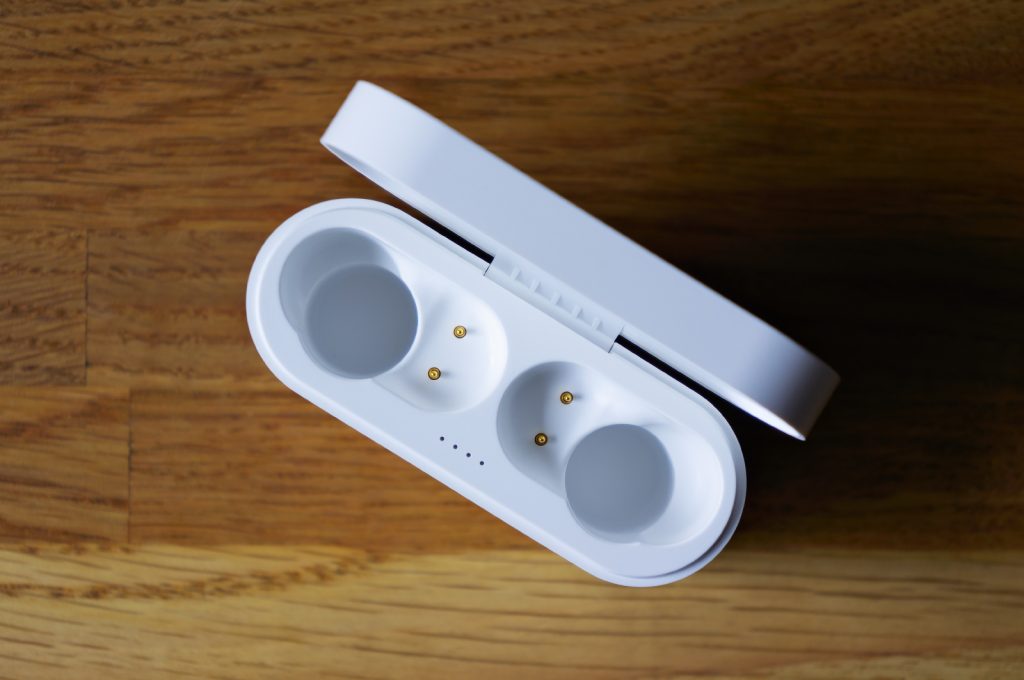
These headphones are designed in the same austere manner – without a single hint of complex shapes or non-functional decor. Everything is very simple and very high-quality here. The speaker grids look like pieces of jewellery. The only visible elements on the case are transparent pixel-sized particles indicating the current headphones state when glowing or blinking.

The case cover is made of… don’t even know what. It’s like a mixture of plastic and paper. And I couldn’t use it because read below.
I don’t have a single complaint about the build quality or design, except for one thing: you can’t really tell the right earpiece from the left one as vice versa, since the earpieces don’t have those useful L and R on them, so sometimes you may feel yourself like a test chimp trying to put the plastic shapes in the respective holes. Makes you want to look for humans in white robes somewhere around.
Ergonomics
ALICE are often said to be too large. Well, they certainly aren’t small, but where do you think this 8-hour battery operation comes from? Exactly. The headphones actually fit okay, don’t fall out when walking and feel comfortable when under a knitted hat. Aaand everything seems to be pretty good and all if it weren’t for a small ergonomics blunder: the ALICE sound ducts are too short for the eartips provided. Or the sound ducts are normal-length, but the shape of the eartips doesn’t match them? No idea. The thing is that you just can’t push the headphones deep and securely enough. Personally, it took me quite some time to pick the right eartips so that the earpiece wouldn’t grip inside the ear canal itself, but at the its entrance — in this case, I picked the large spherical ones coming with the Moondrop Quarks DSP headphones (which I hope to tell you about very soon, too).
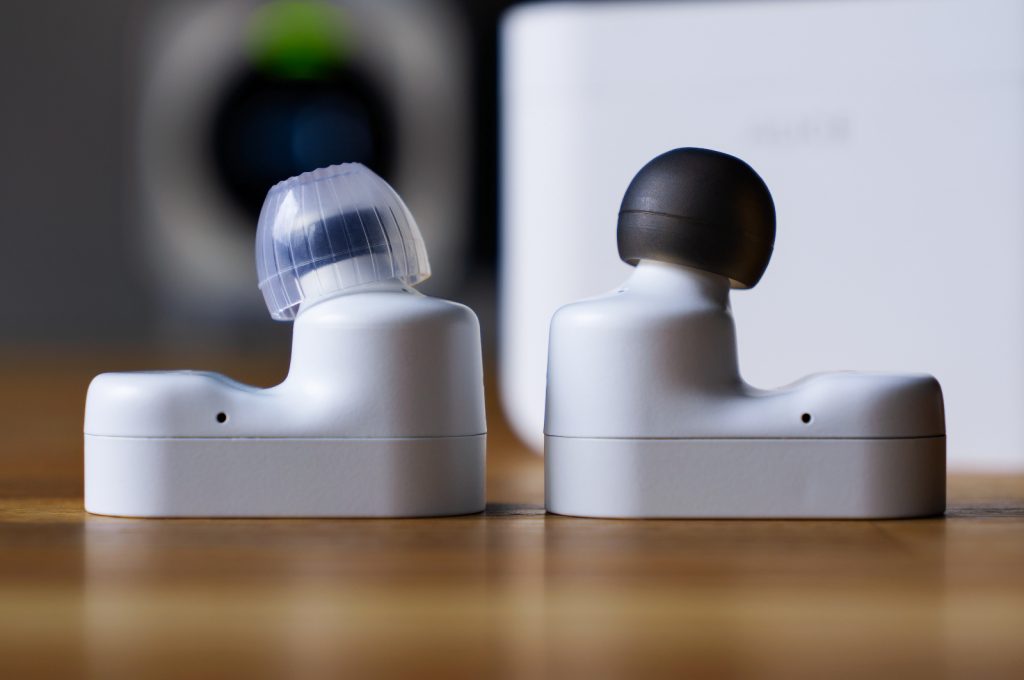
Those made the fit comfortable, and the sound insulation turned out to be just enough to actually create some articulated subbass. To make it very clear: the ALICE come with two sets of eartips – the ribbed Moondrop Spring Tips (already said my word about them here) and the second ones made of thermoplastic elastomer (the XELASTEC SednaEarfit-style ones. Both sets are of excellent quality, but when using them with the ALICE and given some physiological umm features of my ears, neither pair worked.
By the way, it’s very user-friendly that you can take the headphones out of their case without losing them immediately on the ground – they aren’t slippery at all. The touch control pads are the easy targets for your fingers, too.
And the case is, well, JUST GIANT, though lightweight. It’s probably bigger than the Sony WF-1000xm3’s by half. And if your case ever gets dirty or something, you can just wipe it with a rag, but it’s not the case (ha! what a homonym work!) for the case cover: not only it makes the device even bulkier – it’s kind of difficult to clean, too. Why would one need to use it, anyway?
Usage experience
Here’s the ALICE operation logic: once the case is opened, the headphones LEDs flash and the headphones immediately try to connect to the last paired device. When the headphones are back in the case, the connection is automatically terminated. Looks easy breezy, right?
The reality is harsher than you’d think and differs significantly from the easy breezy stuff you’ve just read. The headphones may disconnect from the sound source immediately after connecting, as well as while you’re actually listening to your Britney Spears. They may also keep on ‘Hit me baby one more time…’ when already in their case with the lid closed (it’s like a music box mode or something: no ballerina though). They may refuse to identify themselves as a music output device and let you only make calls with them. I mean, it’s a whole lot of bugs and fails, ALICE. Shame on you. If somebody’s ever drawn any comprehensive list of potential troubles with TWS headphones, all of those troubles sit right in the ALICE. Interestingly, they all can be rectified in two ways: either by disconnecting and reconnecting the headphones, or by changing the firmware to the previous version, then back to the newer one. But I’m going to cover that below.
Let’s talk about the controls now. You can’t customize the controls. Like, at all. One tap – play/pause, two taps – next track. You’re officially prohibited from wanting to change it. And it’s all the same for both earpieces: it doesn’t matter what hand you hold your ice cream with, you can do this control minimum with either hand. Well, the tap’n’hold enables a certain VDSF+ (Virtual Diffusion Sound Field) technology, which does something with your sound. Volume control? Switching between presets?
‘Nuh, you don’t need it,’ they probably said.
The ALICE also don’t have any additional functionalities. No active noise reduction, no acoustic transparency mode, no ‘talk-to-hear’ or voice assistant support. Not even an auto pause when taking one of the earpieces out.
The headphones connection and disconnection as well as the VDSF+ activation is announced with the dumbest child’s voice ever. Which would be loved by some… but still be stupid. By the way, the announcement volume can’t be adjusted while your music stays as loud when the annoying kid has something to say – that’s why you can’t really catch what it says.
However! I don’t really want to besmirch the ALICE, so here’s a nice thing about them: the connection range is pretty decent – no interruptions within. And the stated manufacturer 8-hour battery operation at medium volume are there, of course.
Mobile app
The hell starts at the installation. You can download the latest version of the Moondrop Link proprietary Android app on the manufacturer’s website, but once you install it, it immediately offers to update – but not by just hitting the ‘Yes, update’ button, no. You need to download a certain APK file via some Chinese file sharing service.
After reboot, the app opens in its full spartan glory – no bells or whistles. Oh, and it’s not even fully translated.

The first menu item, which is an OTA (Over The Air), provides access to all headphones firmware.

Why would you want to poke on them? Maybe the manufacturer doubts that each newer firmware is better than the previous one? Maybe the firmware affects the sound quality? Is there any information about this somewhere inside the app?
The Tuning configuration item allows you to select one of 10 sound settings.

And the Chinese-coded item gives you access to the parametric equalizer.
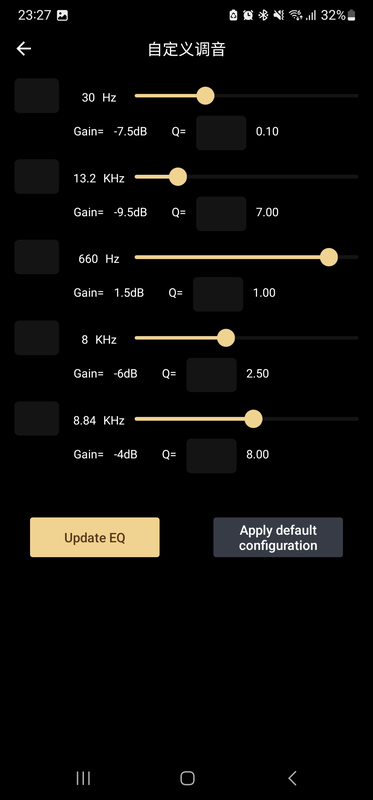
The Product description section is a way to open and read the user manual.
That’s all, folks! No bells or whistles, as promised.
The only valuable feature is, of course, the parametric equalizer. Not the most intuitive one, I’d say. There are 5 points, and they all have the Peak type (a bell-shaped filter). No frequency response visualization to be found. That is, if you, the proud ALICE owner, don’t possess a measuring rig, you’ll need to customize the sound by ear. Using the parametric equalizer. And you know what? Well, it barely works. Firstly, if you try to change and save more than one value of any item, such changes won’t be saved. Secondly, no custom presets are allowed. Separate presets for different music? Pfft. Thirdly, sometimes the headphones simply blank out and forget your settings. They switch to their standard settings right after you open the equalizer screen. And the volume level shoots up, yeah. Fourthly, you can only try and play with your settings during the music playback. Fifthly, even with the music playing, the equalizer settings sometimes aren’t even displayed, so you need to kill the app and open it again. And finally, when you select any standard preset, the custom equalizer settings are reset.
Could it be even sloppier and more user-unfriendly, please?..
And, again, there’s just no way to configure control gestures with the app. The charge level for the headphones or the case aren’t displayed, either.
The overall experience of using the Moondrop Link with the ALICE can be described just as simple: if the thing works — don’t touch it! I’d say, if it suddenly so happens that the headphones connect to the sound source without any problem, then turn off when put back in their case and (wow) don’t go blank with your custom equalizer settings (the settings are stored by the headphones, as I understand), then the most reasonable thing to do is to remove the Moondrop Link and to never look back. Because you never know. If any other well-developed headphones software allows you to configure, customize and adjust some parameters, then the Moondrop Link occasionally allows you to just use the ALICE. Like, not always. Not when you want it.
Quick specifications overview
- Design: in-ear closed-back.
- Drivers: 1 dynamic 10-mm one.
- Bluetooth version: 5.2.
- Supported codecs: AptX Adaptive, AAC, SBC.
- Multipoint: available.
- Active Noise Reduction (ANC): not available.
- Battery operation: 8 hours. The case provides up to 5 full charges.
- Moisture protection: not stated.
Sound: subjectively
I’ve been testing these headphones for about 20 hours with Galaxy Note 20 Ultra as the sound source, Hiby R5 player and the PC QCC3040-based Bluetooth submitter.
Here are three general things to note.
- The ALICE are very, very loud. Around half their volume bar is the maximum volume for the WF-1000xm4. I didn’t even try to rock it to the maximum volume, to be honest. I mean, I’ll certainly need my eardrums in the future.
- The ALICE hiss when there’s no signal, and it’s very easy to hear. It’s as if the amplifiers are always on at full power, and the sound control is only available via software, not hardware. However, it’s not necessarily a terrible thing. A blunder, yes, but not any kind of catastrophe: it’s not even perceivable when outside.
- The VDSF+ function doesn’t affect the sound: checked empirically and via frequency response study. There may be some kind of channel mixing, but I didn’t really hear anything like that.
Since the ALICE’s sound is always determined by one of the 11 (including custom) equalizer settings, I think it’s important to note at this stage that 8 out of 10 standard presets are crappy as hell. Both by ear and by measurements. That’s why I’m going to be reviewing the ALICE’s sound from the Moondrop Target and In-ear Target preset perspective. The custom tuning, too.
When using the Moondrop Target preset, the headphones deliver a graph with a slight V and additionally emphasized upper part of the middle section and subbass. The sound is then bright, very expressive and ‘transparent’. This is exactly the case when the sound is real, perfectly credible even though the delivery itself is clearly a bit prettier than it actually is. This could be one of the best Chinese-style sound implementations. I mean, the Audeze are about some conditionally American sound, the Focal make it European, and the STAX – Japanese. In any track, the vocals are accentuated, especially female ones, they’re positioned extremely close to you (even too close sometimes, but isn’t it awesome when a lady is that close, huh? DEPENDS ON THE LADY). The lower part of the middle section sounds dimmer, and this kind of deprives the sound of its physicality, but this is compensated by a powerful and ‘fast’ subbass.
The subbass actually deserves its own paragraph. Because it’s just magnificent. Technically, the headphones reproduce the entire sound range perfectly, but the subbass is just great. Remember that no-signal hissing I’ve mentioned above? That is subject to interpretation: I think the amplifiers control the speaker very well precisely because they’re constantly working at their full power. And voilà – a disadvantage turns into an advantage (a feature, not a bug).
I’d say the Moondrop Target preset perfectly suits for listening to some more vocal tracks and live instruments, but only in a more or less quiet environment: with the volume increasing, the section at about 3 kHz amplifies and puts some unpleasant pressure on your ears. And that accent around 8 kHz becomes too sharp. This is why if you go outside and, for obvious reasons, want to make it louder, just set the different tuning.
The In-Ear Target preset is similar to the previous one, but offers a radically emphasized subbass, as well as some highlighted fractions of the upper-range frequencies and, logically, an even more pronounced V-shape. Despite some ‘sharpness’ and ‘shrillingness’, this preset is more likely to be of interest for most users. It’s also the closest one to the Harman curve. Due to all this, any music sounds impressive and very strong, which is amazing. But it’s not too rare when a track is mixed poorly – and then I’d recommend unleashing your inner fastest in the Wild West and pull the headphones out as fast as you can, since things are getting very sharp and ringing here.
Talking about the Moondrop Target and In-Ear Target presets as ALICE’s signature sound, then this is certainly an outstanding and bold tuning for TWS headphones. Most of the average listeners, some unaffected by audiophilia, will say ‘Damn, that’s… wow!’ when hearing the ALICE play, because they’ve never heard such a sound. As for the audiophiles, they’ll say ‘Damn, that’s… wow!’, too. But with a slight hint of not believing that some in-ear wireless headphones can do such a thing. I’m in the second camp, by the way: at first, you kind of don’t believe that the ALICE, those little wireless earplugs, can deliver such power, such a sound stage, such freedom, such purity!
Holy cats, guys!
Me having an inquiring mind, I’m very curious whether it’s possible to make it all even better. And you know what? Yep, it is. See for yourselves below.
Measurements
The headphones were used with the Hiby R5 player (AptX). A measuring rig conforms to the IEC60318-4 standard. For each of the earpieces, the measurements were made until 3 to 5 reliable and stable measurements were obtained for the left and right channels; any deviant measurement results were excluded. The smoothing is indicated on the graphs. I’ve described the limitations of the rig and the headphones measurements in general in this article.
The Moondrop Target preset:
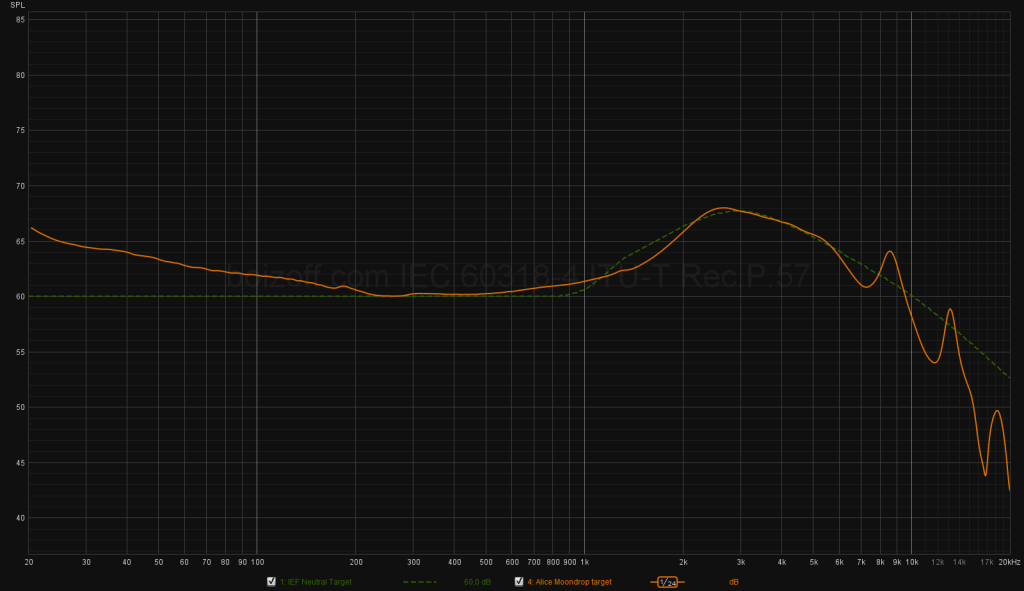
The In-Ear Target preset:
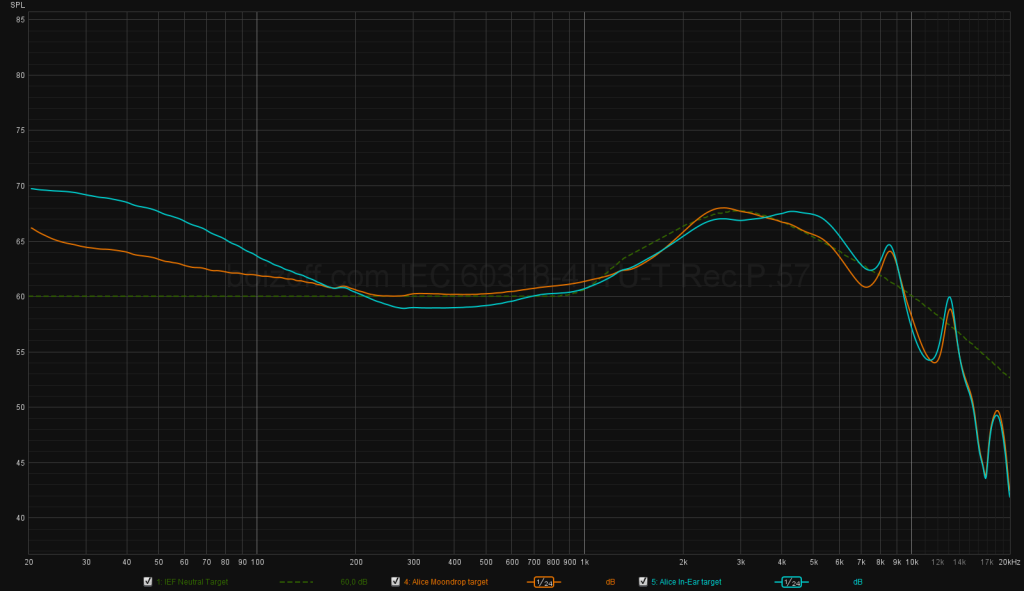
I don’t see any point in commenting on the pics, since the auditory perception showed the same as the measurements did.
Let’s try to make it better, that is, smoother (*DIY music playing on the background*). To do so, you first need to decide which frequency response will be the equalization base. Let’s switch to a custom preset and set Gain=0 for all points:
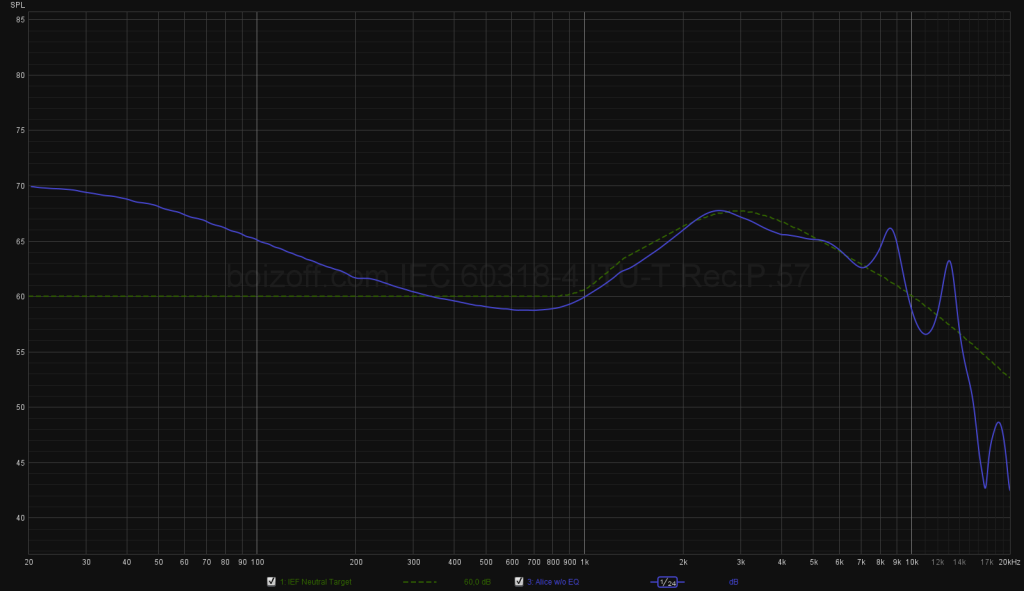
As far as I understand, this is ALICE’s ‘raw’ sound without any equalizers and presets applied. What do we see here?
- +10 dB at subbass
- -1.5 dB at 700 Hz;
- A peak at 8500 Hz (here, the frequency depends on how deep you shove the earpiece into the ear canal)
- A peak at 13 kHz
Now let’s try to remove the high-frequency accents, align the middle part and smoothen the subbass:
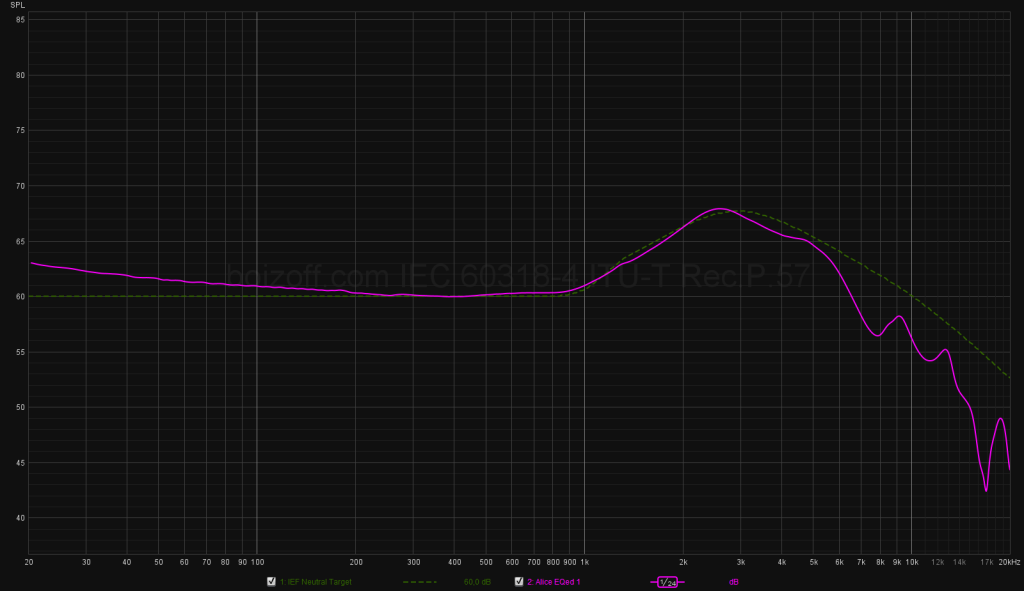
The equalizer settings:
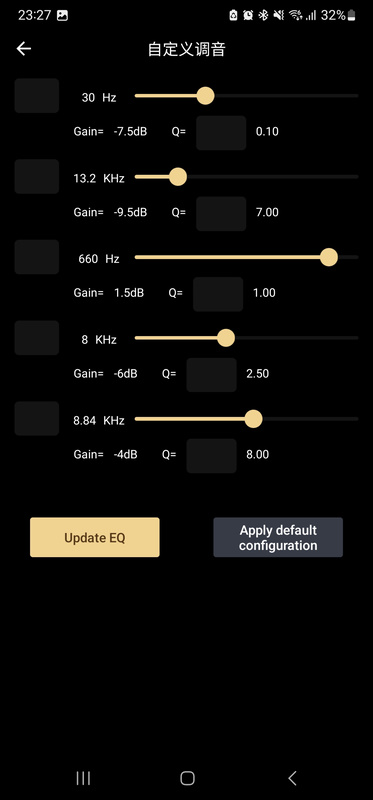
This is an oh so neat and ‘smooth’ sound delivery. I’d recommend applying such a setting for home use or for a quiet street space outside.
But this one still won’t work well if you like it louder for all the reasons described above. Let’s try to come up with a tuning that would sound good at high volume and wouldn’t pop your eardrums with sharpness:
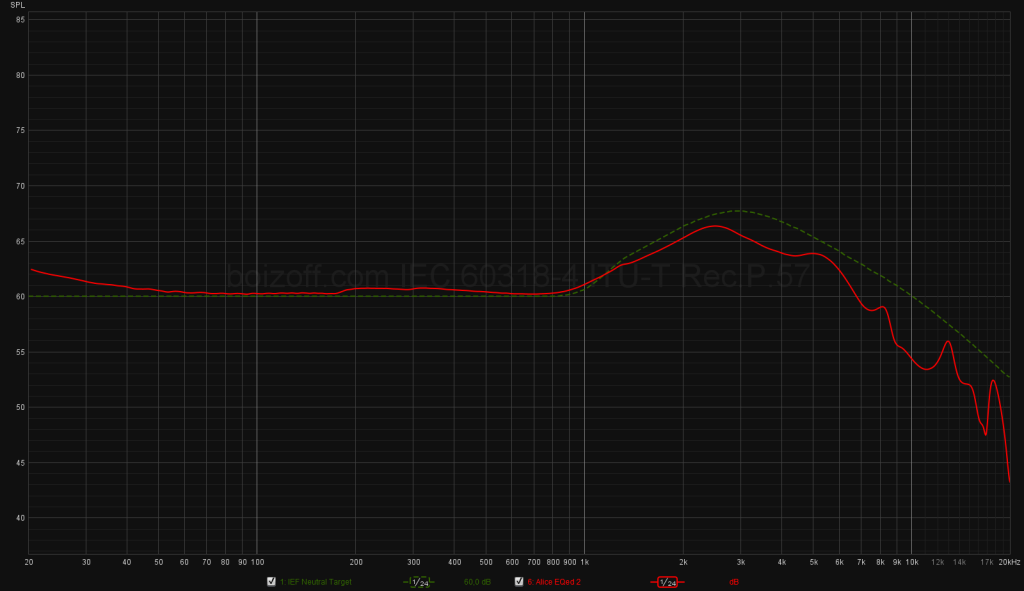
The equalizer settings:
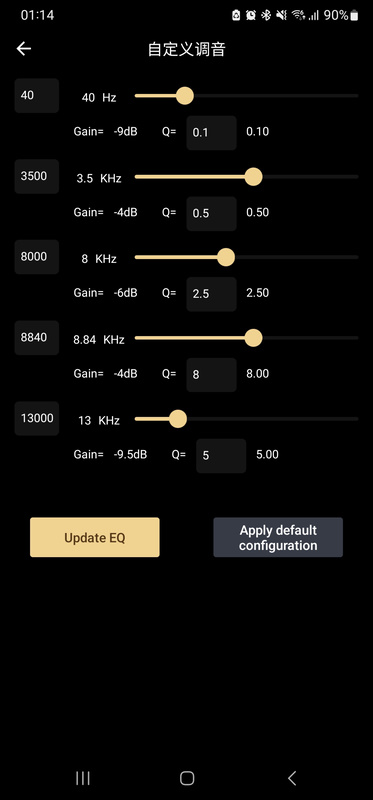
(I’d note that the first slider can actually adjust the amount of bass/subbass, and the frequency of the fourth point needs to be shifted to where you personally feel the resonance – to do this, use the good old Online Tone Generator. I’d also remind you that you can only save one adjustment at a time, that is, bang the Update EQ button at each parameter change for any point. Write it down and memorize, the rare ALICE-owning readers of this article)
And this already pretty much looks like what I, with my unique ears, with the earpads suiting me personally and the relatively high volume I‘ve set, would call almost ideal. This setup lets me comfortably walk down the streets, work out, stay sane in public transport for the entire testing week, and I can responsibly state that I’ve never heard TWS headphones sound so good. To be completely honest, not all wired headphones can do the same, right?
Summary
The Moondrop manufactured some outstanding, no-joke sound delivery. Unfortunately, the effort died out when it came down to other related stuff. The ALICE are awesome if you look at them as the TWS headphones: well-built, made from high-quality components, backed by a parametric equalizer allowing you to really flexibly customize the sound to your taste, and, when properly tuned, delivering a really phenomenally good sounding. Stunningly good sounding. It’s so good that it’s hard to believe at first. You’d want to take them out, wait for a couple of minutes and then shove them back in to make sure it’s true.
Unfortunately, this is the first and the last ALICE’s win. The overall idea is good, but its physical implementation is kind of discouraging.
Everything else besides sound is either so-so, or is as awful as it’s possible. Like there was a ‘Who does it worse’ contest among engineers and developers. Average ergonomics – check. Earpads that don’t even suit these headphones – check. Unstable connection to the sound source? Yep. Disgusting app they didn’t even bother to translate entirely into English? Yeah. How many words are there in the app? No more than a 1000, damn! Well, throw this to the same pile with this to the complete absence of additional features normally implemented in TWS headphones of around $200 in 2023, which are the ANC, talk-to-hear, acoustic transparency, gesture customization, saving presets, etc.
For these $200 or even cheaper you can get, for example, the Soundcore Liberty Pro 3 (review) or Sony WF-1000xm4 (review). Of course, they sound worse even after tuning, but they work stable, can be tamed with settings all you want and have more than enough different functionalities!
Oh wait! What if the manufacturer aimed to create the downright audiophile model stressing the entire focus on the sound quality?.. No, I’m just tripping: it doesn’t work this way. Because, pardon my French, such an INFINITELY SHITTY, deadwood software and connection glitches get under your skin with so much enthusiasm you won’t even find it possible to enjoy the sound. I’d say let’s wait for the manufacturer to fix all of the ALICE’s software bugs – only then it would be reasonable to consider buying them. I don’t really think it’s going to happen: look at the number of firmware version releases! There are 5 of them, 5 crappy versions of nothing.
It all looks like an expensive wireless joke: I strongly recommend you try the ALICE in action in terms of sound if you like some really good sound, and I really discommend the ALICE at the same time! Don’t even consider buying them, it’s a freaking torture engine. The end.

